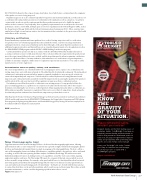Page 47 - North American Clean Energy July August 2015
P. 47
IEC 17020:2012 allows for three types of inspection bodies, two of which have a relationship to the originator
of the product or service being inspected.
Regulatory agencies in each economy frequently leverage these international standards, as well as the use of
accreditation (the independent assessment of conformity to the standard, as well as competence to perform
certain tasks), in order to set the requirements that those products must meet to be eligible for import
and use in their countries. Very frequently, these regulatory requirements focus on safety to the users and
performance metrics. In the USA, multiple agencies set these regulations in the Federal Register (CFR), such as
the Department of Energy (DoE) and the Federal Communications Commission (FCC). Other countries have
similar lists of legal acts and various entities (such as ministries) that contribute to the protection of the health
and wellness of the citizenry.
Voluntary certiications
Beyond mandatory requirements from regulators for accredited testing, inspection, and/or certiication
of a product, there are voluntary programs that exist around the world, created to encourage innovation
and improvement in certain areas of industry and to show (through certiication) that these products meet
additional requirements above and beyond those set as a baseline by government or local regulations (such as
the EPA’s ENERGY STAR program and the USGBC’s LEED Building Certiication program).
Certiication bodies operate not only in accordance with the ISO/IEC 17065:2012 Standard, but also in
accordance with one or more Certiication Schemes. hese schemes deine the requirements the product must
meet, the steps it must follow to become certiied, and the steps that must be taken to maintain certiication
(a process called surveillance). In many industries, this maintenance of certiication is of great importance,
as failure to maintain compliance with scheme or regulatory requirements may lead to a very costly recall by
manufacturers, or worse, legal issues.
Accreditation ensures quality, safety, and conidence
he clean energy industry can certainly beneit from encouraging use and acceptance of accreditation in the
testing, inspection, and certiication of products. he added beneit of voluntarily seeking out “the independent
evaluation of conformity assessment bodies against recognized standards to carry out speciic activities to
ensure their impartiality and competence” has already been realized by dozens of testing laboratories and
inspection and certiication bodies around the world. he improvement in assuring the quality of the products
and the safety of the end users has been felt by regulators in many areas that accreditation touches.
For industry areas still in their youth, accreditation is an exciting prospect. It may greatly facilitate the
process of having products accepted for use in countries or localities for the irst time, where there may be
hesitation over allowing the use of non-accredited products. Many organizations also utilize accreditation as a
diferentiator or qualiier to promote recognition of their services over that of competitors, broadcasting the
fact that independent evaluators have found them competent to perform those services.
WE
Mike Buzard is the Product Certiication Program Manager at the American Association for Laboratory Accreditation KNOW
(A2LA) and the staf contact for the EPA ENERGY STAR program, the Design Lights Consortium and DOE Lighting
Facts programs for lighting testing laboratories, and Sustainable Energy ield of testing. He has been employed as an THE
Accreditation Oicer for A2LA since January 2010.
GRAVITY
A2LA | www.a2la.org
OF YOUR
SITUATION.
If you’re tethered for safety,
shouldn’t your tools be?
Dropped objects are the third leading cause of
workplace deaths. Tools@Height, from Snap-on
Industrial, prevent deadly accidents thanks to
built-in drop prevention. Attachment points on
every tool are purpose engineered to improve
safety and productivity while preventing fatal
New thermography tool
injuries and costly foreign object damage.
Opgal has announced the new herm-App TH device, dedicated for thermography applications, allowing
Lower your “At Height” risk today. Contact
professionals to take accurate temperature measurements captured on high resolution thermographic photos your Snap-on Industrial account manager,
& videos and immediately transmit them via email, messaging, or ile sharing platforms. he device ofers a or call 877-740-1900 to speak with a
suite of thermography features including: full radiometric capability, multiple color palettes, video, and sound Tools@Height specialist.
recording, as well as eicient reporting and data analysis. In addition,herm-App TH enables users with
snapon.com/industrial
Android smartphones features including: touchscreen capabilities, round-the-clock connectivity, ongoing
application updates, and more. he herm-App TH is part of a category of thermal cameras which are used
in the renewable energy industry. For example: solar panels which have a technical problem often heat much
more than panels around them. By using herm-App TH, the owner or technician of a solar panel ield can
scan and easily track non-performing panels. On wind farms – the blades are checked with thermal cameras
to ensure they don't have cracks and other problems, which result in a special heat stamp. his is done as both
preventive maintenance, and as a tool for diagnosing a problem after it has occurred.
INDUSTRIAL
Opgal | www.opgal.com
North American Clean Energy 47


